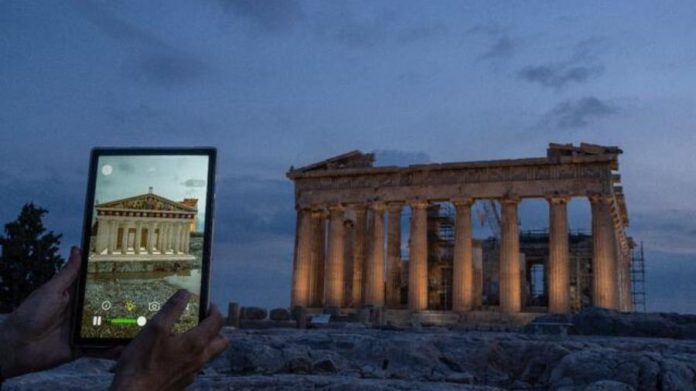This holiday season, tourists visiting the Acropolis in Greece are in for a groundbreaking experience that promises to settle one of the world’s most contentious debates regarding cultural heritage. All they need is a smartphone to unlock a remarkable journey through time.
With the help of an app supported by Greece’s Culture Ministry, visitors can point their phones at the Parthenon temple and, thanks to augmented reality, marvel at the sculptures currently housed in the British Museum in London, which Greece fervently seeks to repatriate.
The app, aptly named “Chronos,” transports users to a vivid world where the Acropolis regains its former glory.
It reveals details that have long been hidden from the naked eye, such as the vibrant colors that adorned the sculptures and even the presence of a shallow pool of water beneath a statue of the goddess Athena in the Parthenon’s main chamber.
Tourists are enthusiastic about this immersive experience, appreciating the opportunity to see history in color and feel more connected to the ancient site.
For many, it’s a chance to avoid the crowded uphill walk and long queues that often accompany visits to these iconic monuments.
This technological innovation enhances the tourist experience and aligns with Greece’s goal of promoting year-round tourism, which is crucial for its economy.
Despite challenges like wildfires on the island of Rhodes, Greece has seen a significant increase in inbound visitors and revenue.
“Chronos” harnesses augmented reality to merge the ancient world with the present, a technology gaining momentum in various sectors.
While tech giants like Meta and Apple are investing heavily in VR headsets, augmented reality remains accessible to the masses via smartphones, making it the primary delivery platform for AR experiences.
Maria Engberg, an augmented and virtual reality expert, anticipates that travelers will soon enjoy more integrated experiences with options for sharing and access to digitized content from museums and archives.
In Greece, the Culture Ministry and tourism authority have embraced technology, leveraging platforms like video games and digital tours to enhance accessibility to ancient monuments.
As we look to the future, there’s great potential for AR and VR to revolutionize how we engage with cultural heritage, offering new perspectives and immersive storytelling experiences.
With the continued advancement of technology and networks, the possibilities are boundless, ensuring that history remains accessible to real and virtual visitors worldwide.
Source: Tbsnews.net

